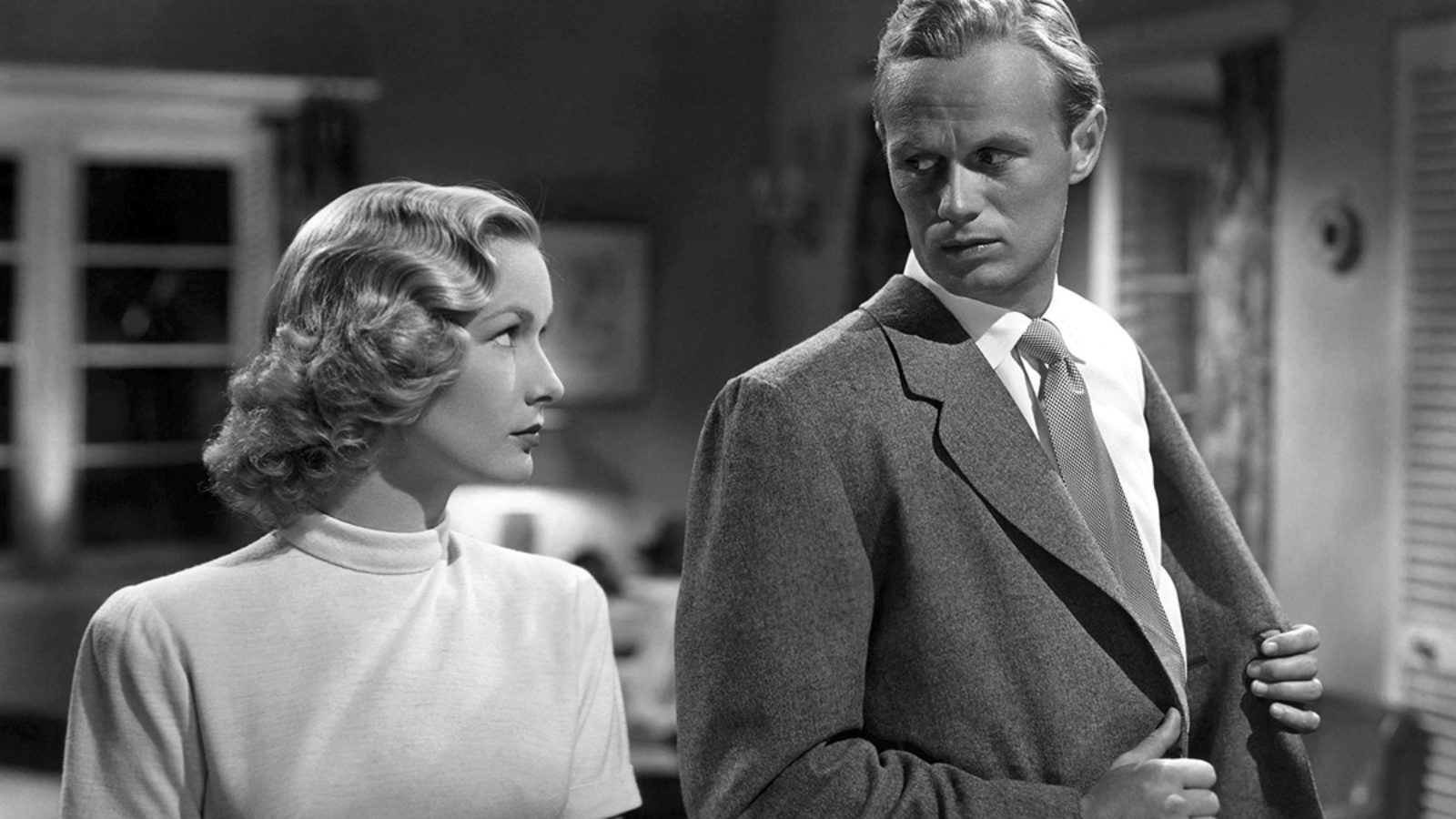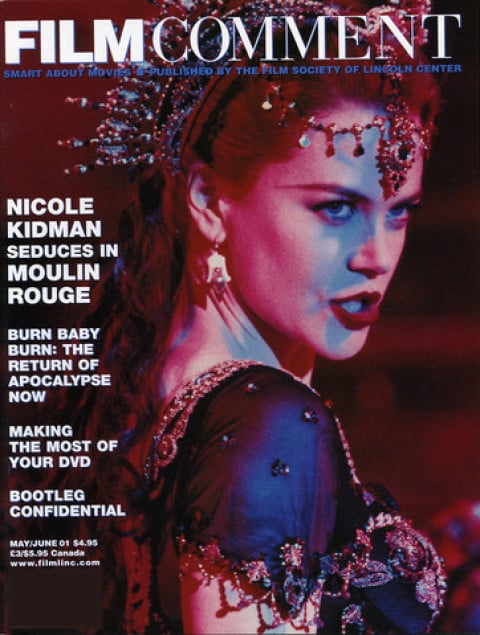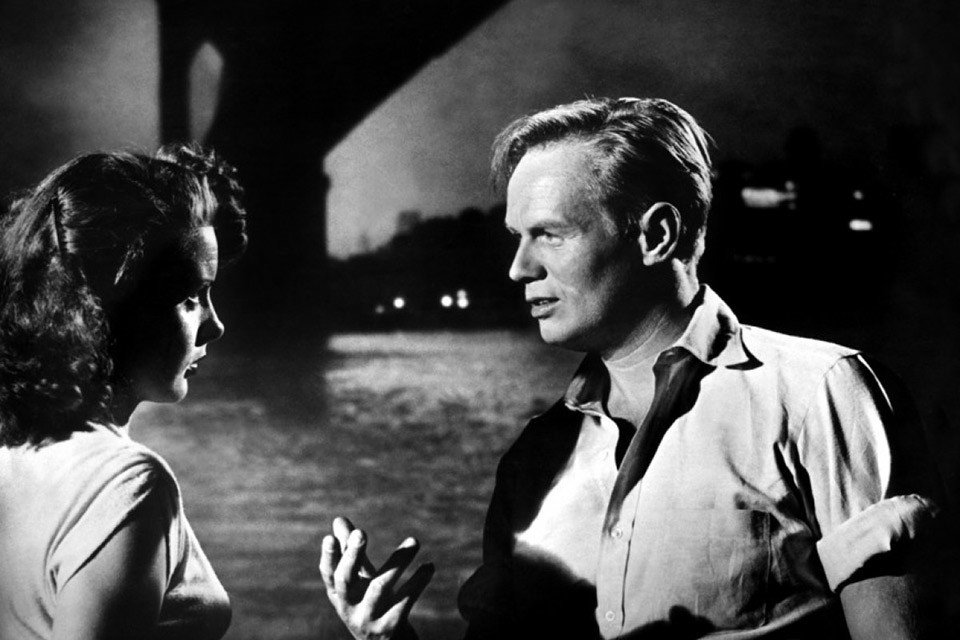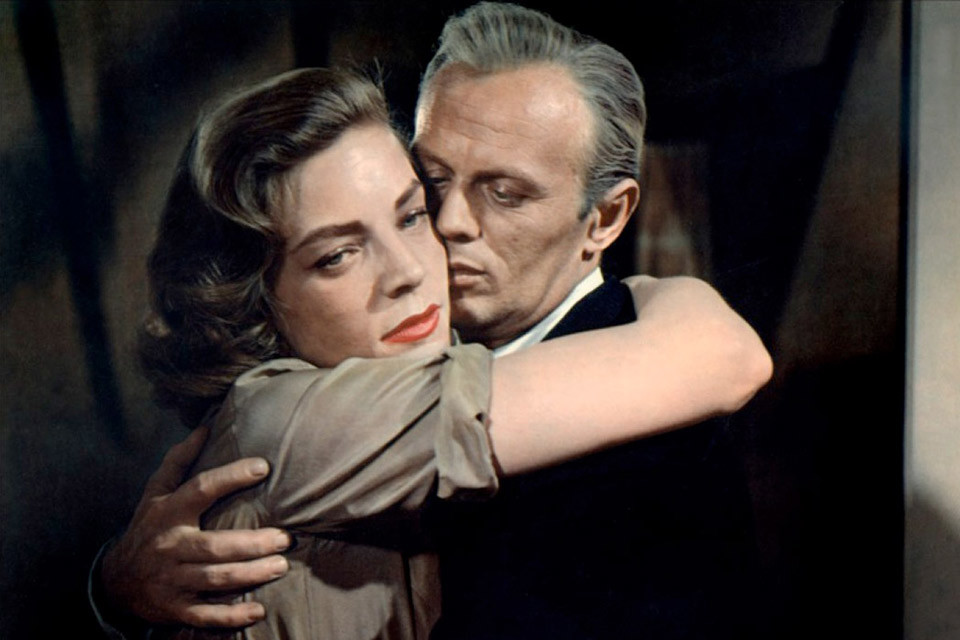
Hidden Star: Richard Widmark
Less drawn to showstopping outbursts than John Goodman but much more of a star, only slightly more flamboyant and extroverted than Red Garland, the most recorded and least obtrusive jazz musician ever, Richard Widmark may well have been the most dependable actor of his generation. Widmark, who made 74 movies between the 1947 Kiss of Death and the 1991 True Colors (not counting his guest appearance on I Love Lucy), is the kind of star whose mastery sneaks up on you. He was equally at home playing psychotic punks (Kiss of Death’s Tommy Udo, Road House’s Jefty), affable two-bit grifters (Skip in Pickup on South Street, Night and the City’s all-charged-up Harry Fabian), trained professionals trying to beat the clock (Dr. Clinton Reid in Panic in the Streets chasing down a trio of gangsters with the plague, or Dr. Stewart McIver in The Cobweb staving off a catastrophe over the choice of drapes at his psychiatric clinic), or, in the final stage of his career, locked-down professionals on the brink of delirium (The Bedford Incident’s maniacal cold warrior, Coma’s stoically evil chief of surgery). Widmark was the career-professional-as-star, a job description that no longer exists. He was a pure product of the studio era—Fox, to be specific, where he was under contract for seven years. In those days, as the 83-year-old Widmark told me recently over lunch, “everything was efficient, and it wasn’t a federal case like it is now. Jesus, you make a picture now and everybody’s career hangs on the weekend gross. There, we figured if we got one out of five, we were ahead of the game.”

All things considering, Widmark’s average was pretty good, more like one out of three. Even the ones he considers lousy, like De Toth’s Slattery’s Hurricane (“They showed it to Zanuck, and he said, ‘What the hell are we gonna do with this?’” or The Long Ships (“We were in Yugoslavia for six months. I wouldn’t say it was fun. It was nutty”) or Run for the Sun (“I used to say to the kids, If you’re bad, you have to watch Run for the Sun”), were no big deal. It’s a better average than that of his longtime neighbor Robert Mitchum. While it’s true that Widmark never had an icon-maker like The Night of the Hunter or Cape Fear, it’s also true that he led a much happier, more level-headed life, and cared more about his craft. “He was a good actor, and he’d never admit it,” Widmark said of Mitchum. “A complex guy. You couldn’t shut him up. One night I had a party for William Shirer [author of The Rise and Fall of the Third Reich and Berlin Diary]. It was so embarrassing, because Mitchum spent the whole evening explaining the German problem to Shirer. And he’d never even been to Germany.”
Like his hero Spencer Tracy, Widmark always kept the flame low, flowing from one emotional state to the next rather than foregrounding his effects, filling any performance with seemingly offhand details, good instinctive choices cunningly disguised as the private traits of his character. Widmark’s voice, that wonderfully slow, flat Midwestern instrument, dropped a level or two in admiration for Tracy: “I learned more from watching Tracy than from any acting school, ’cause I saw everything he did from the time he started. He was amazing—hard to match. He was just as good when he was young as he was when he got older.”

Pickup on South Street
But that’s true of Widmark, too. From the beginning, he worked from tension, his characters’ minds compulsively angling, ruminating, trying to get a fix on some brain-twisting problem. In the gallery of postwar malcontents—Mitchum, Lancaster, Peck, Cotten, Douglas, Ryan, Andrews—Widmark was the least stylized and dreamy, the most earthbound. He was extraordinarily beautiful—when he was young, his large-boned face looked as if it had been sculpted out of marble—but he was also convincingly ordinary, suggesting any number of everyday figures: a face you might spot on the seedy side of town, or a repairman, or maybe your lawyer or your psychiatrist. And unlike the stocky Tracy, Widmark was at home on the range, despite an inauspicious start on horseback in Yellow Sky. “We were in Death Valley in July. It was 120, 130. Jesus, it was awful. I had to do a little scene with the horses, and I was new with horses at the time. I got my foot in the stirrup and it slipped. [Director William] Wellman said, ‘That’s it—you’re not doin’ it again.’ In the picture, you see me stick my foot in, and then there’s a cut, and I’m already on the horse.”
Widmark had a quiet genius, developing a convincing psychological mechanism for each character. At the heart of many Widmark performances is a disappointed child within—not a bad intuition about American manhood. His Jefty in Road House is an astonishing piece of work. Widmark’s smooth features and blond hair always suggested an overgrown boy, as did his head, which seemed a little too big for his body. When he’s trying to lay claim to Ida Lupino’s Lily, he’s as awkward and overeager as a 12-year-old—he lurches into her private space, an unsuccessfully suave smile creases the corner of his mouth, and you can practically feel the clamminess of his hands as he touches her shoulder. Like Tracy, Widmark was less a graceful mover than an ingenious one, and he had a way of angling his upper body into clean visual lines, using it as a weapon of insolence (Pickup on South Street, Night and the City, Madigan), arrogance (The Bedford Incident, Coma), or as a bulwark against a neurotic onslaught (The Cobweb). But besides that drawling voice, his greatest asset was his face, made for close study. The opening of Pickup on South Street is a wonder, an alternation of close-ups between Widmark’s pickpocket and Jean Peters’ unwitting communist moll, in which he builds a careful, subtle gradation of sexual intensity beneath an appearance of nonchalance, all the while keeping his concentration so that he can lift her billfold out of her pocketbook. Later, as he’s being questioned by a cop, Widmark uses his arching eyebrows to devastatingly sarcastic effect, an arrogant smile beaming in mock humility.
In his later, beefier years, after his face had gotten a good baking in the California sun, Widmark put the smile/arched brow combo to even more devastating use, whether poignantly reaching out to his bored wife in Madigan or imperiously putting off a visiting doctor in The Bedford Incident. It all adds up to a multi-faceted portrait of the postwar American male, across a 40-year time span.
Yellow Sky
Widmark began in the theater, which he insists is the only real way for actors to learn their craft. “There’s no place to learn to act but in the theater. It gives you a real solid background. In movies, you don’t do anything, and you’re a great actor. The less you do, the better.” He started in college, where he briefly taught acting, then went into radio and then on to Broadway, where he had his first success in the 1943 production of Kiss and Tell. Widmark harbors no special love for the theater, despite his fondness for it as a training ground. “I don’t like starting to get nervous about four o’clock every afternoon. I wouldn’t have traded it for anything, but I didn’t like that. But I was a little weird. Even before I was married, I lived in the suburbs, so I didn’t hang around nightspots. I lived out in Bronxville—I had a room out there, for five dollars a week. So I missed a lot. But I’ve always hated cities. I came to New York, a cornball from the Middle West, and I just didn’t like it.”
Widmark began his career in movies with one of his greatest signature moments, the scene where the gleefully psychotic gangster Tommy Udo pushes Mildred Dunnock in a wheelchair down a flight of stairs in Kiss of Death: “My first day’s work was when I pushed Millie Dunnock down the stairs. I’d never been in a movie. Hathaway, he didn’t say anything. He just wanted me out.” Impossible to believe, but Henry Hathaway didn’t think that Widmark was right for the role, and wanted a local East Side small-timer named Harry the Hipster instead. “Henry didn’t want me in the worst way. It was a very small part—I only worked for a few days. The first week I was working—oh, he was giving me a terrible time. On the set, he was very inarticulate. Part of it was frustration—he couldn’t get over what he wanted from the actors, and he’d go crazy, even with old friends, like Cooper in Garden of Evil—he’d scream at him. Anyway, Henry embarrassed the hell out of me in front of a lot of my friends who were doing extra work and so forth. And I said, To hell with this. So I pushed everyone aside and I left. It was lunchtime. I was walking down the street, and I was going to take the train home to Bronxville—I’d had enough of the movies. Henry’s assistant came running after me, and he said, Come have lunch with Henry. And I said, I don’t want to do anything like this. I’m out. But I went to lunch with Henry and his assistant and I sat there, and nobody said anything. It was just a quiet lunch. And we went back and picked up where we left off, and from there on it was great. Henry and I became fast friends. We made six pictures together, and I was a pallbearer at his funeral.”
Widmark claims that he’s never seen one of his films all the way through, and as we went down the roster of his collaborators, he talked more about the people than the movies. He has very fond memories of John Ford, with whom he worked on Two Rode Together and Cheyenne Autumn. “Underneath, he was a very complex guy. He was a nutball, but I was fond of him. He was in his last days then. He’d hit the bottle for two or three days and you couldn’t get him out of bed. For part of Cheyenne Autumn, he was clear. But for part of it, he wasn’t.” He has a similarly indulgent feeling for Sam Fuller. “I called him the Grandma Moses of filmmaking. I don’t mean that in a derogatory way. He was lean, to the point, kinda primitive, no false moves, no froufrou. He’d been a newspaperman, and he kinda made pictures like a newspaperman. He had a habit of starting a scene by shooting a gun. The first day of shooting, he shot the gun, and I said, ‘Whoa, Sam…’ He didn’t do it anymore. I liked Sammy.” His lack of fondness for The Cobweb didn’t affect his feelings toward Vincente Minnelli. “Minnelli was a good director, a very fussy director. He’d spend hours deciding where a cigarette lighter should go.” In a way, Widmark’s greatest admiration is reserved for Zanuck. “Zanuck was a very astute producer. Tough guy, but he was astute. He loved writers. Crazy about writers. He really knew what he was doing. He was a very good filmmaker. A good editor.”

The Cobweb
“I’ll tell you the truth,” Widmark confided. “Movies kind of bore me now. I get restless. I want to go home. There’re very few movies that grip me.” He lost the desire to act after the death of his wife of 55 years, Jean Hazlewood (he’s now married to Susan Blanchard, a friend for 30 years and the former wife of Henry Fonda). And when he discussed his career, it was with a detached fondness. He became most animated when we talked politics. A lifelong liberal (“I’ve never been a real activist—I just shoot my mouth off”), Widmark remains mystified by the massive popularity of Ronald Reagan: “When I knew him, he was an affable, boring fellow. Now he’s an icon. It’s incredible.” And, like half of America, he is doubly mystified by Reagan’s spiritual heir, our current president.
As we were leaving, we told Widmark how much we loved his work, and even though he’s an old pro, his shock seemed genuine: “Gee, I’m so glad I came to lunch.” This unassuming Midwesterner, who did almost half a century of quietly brilliant work, may not know it, but the American cinema would never have been the same without him.







